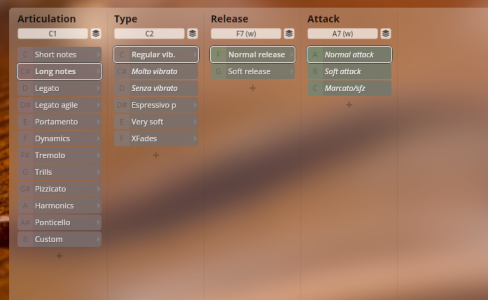Vik
Vi-k
Oh.It can do maybe 0.01% of that - which is still pretty frikking amazing if you ask me.
Oh.It can do maybe 0.01% of that - which is still pretty frikking amazing if you ask me.
Not really, though. What I suggest is a library that lets you choose the amount of vibrato that you want through a selection of patches: legato with little vibrato, legato normale vibrato etc.It's actually quite close to being that special, vibrato oriented library that you may suggest – on paper
But can it do this?

Yeah, I don’t think it’s an especially well named library as even full tilt, it strikes me as rather well behaved and restrained. I mean at the higher dynamic layers the vibrato is there but it doesn’t hit you over the head with it. Still, it’s a lovely sounding library and the first library I reach for my lyrical stuff. I happen to like the choices SF made for it, and the way it passes from dynamic/vibrato layer to dynamic/vibrato layer. But it won’t handle everything.I know that SAS doesn't offer vibrato control, and that (combined with what I've heard in demos and walkthroughs) gives me the clear feeling that SAS isn't capable of doing appassionata across all the dynamic layers.
It seems to be a common misunderstanding that 'deeply emotional' is something we only want when played loud. I don't doubt that each layer in SAS 'captures an expressive performance in itself' – what I'm asking about is if it also offers appassionata when not playing loud. I can't think of anything in orchestral music sounding more beautiful and expressive than the sound of string players who are playing relatively quiet but does it as espressivo as it gets.
Of course SF had to make some decisions when making this library, and unfortunately one of the decisions seems to have been that they tome down the expressiveness (appassionata/vibrato) in the quieter dynamic levels – just like pretty much every other string library does.
There are a few companies out there which have made libraries with a dedicated CC devoted to vibrato, btw. Why do you suggest that offering dedicated vibrato control necessarily comes with 'it's own problems'?
Interesting... I'm trying to figure out why this would be better than simply switching between vibrato levels with a CC? Using a CC (within the same patch) would let use different levels of vibrato within the same piece (or bar) without using a different patch, different track or similar – but what would be the benefits of having to change to a different patch?What I suggest is a library that lets you choose the amount of vibrato that you want through a selection of patches: legato with little vibrato, legato normale vibrato etc.

I think SAS gets its very smooth transition between dynamic layers and vibrato in part because it is baked in. Crossfading vibrato comes with its own set of issues and would greatly complicate getting right what this library now does so well. So I'm willing to take the limitation. I imagine that SF could set up various other vibrato scenarios without too much trouble. But I'm not sure they can make vibrato an independent variable (as it would need to be to dial it in on a CC) and maintain the quality of the sound they are getting, which seems predicated on having a set design for how the patch is going to work with dynamics and vibrato. Yes, other libraries can do this kind of CC with vibrato on a crossfade, but there is a fuzziness to that crossfade that is not there with SAS.Interesting... I'm trying to figure out why this would be better than simply switching between vibrato levels with a CC? Using a CC (within the same patch) would let use different levels of vibrato within the same piece (or bar) without using a different patch, different track or similar – but what would be the benefits of having to change to a different patch?

Are you thinking of something like this?
But can it do this?
With eg. four different levels of vibrato (+non-vib), including for the pp(p)-range, CC1-25 could represent no vib, 25-50 could represent little vibrato and so on. No x-fading involved. VSL, CSS and others offer vibrato x-fade, but I'm not discussing x-fade vs x-swicth – I just think that with so many libraries doing this the same way, it's a market out there for a library which acknowledges that there's sometimes a need for the combination of a generous amount of vibrato and really quiet playing – a tremendously beautiful sound.Hence my idea to get several intensities to choose from. We were then not stuck with either the developers choice of vibrato intensity, or compromised crossfading. Rather we could choose the intensity for each new note. This would greatly increase the variability in our mockups

Wow that is a beautiful piece. Thank you for sharing and yes those strings sound beautiful.......and the BrassTchaikovsky's 5th and 6th Symphonies are amazing. I don't think Appassionata could fully duplicate the Romantic sound in the soft, expressive dynamics, but it would be interesting to see how close a mock up of some sections could come. I do like Appassionata and find it generally very expressive.

But can it do this?
This is the LSO.CSS sounds so much like the strings here!
My goodness Alex really nailed it with that lib.
They are crossfades, but done in such a way that the user can get the 'true' dynamic sample isolated at certain points on the modwheel:
ff - 127 (100%)
f - 95 (75%)
mf - 64 (50%)
mp - 31 (25%)
pp - 9 (7.5%)
I agree that it could have been more molto.I think the mf layer could benefit from being more molto, but I'm still more than satisfied with it
I read that as 'Vik, don't buy Appassionata now, because AR-M will offer something you will be more happy with."This release did give me quite a few more ideas going forward, which will certainly be in the AR Modular.

That problem would have been sold if CSS included a way to type in the exact value for the each of the 'pure' layers, since this effectively gives us vibrato cross-switch in vibrato crossfade libraries.CSS and some others do retain a fair bit of vibrato at lower dynamics, but it often still doesn't sound right to me, even when you want that sound, because of the programming of those libraries
That's just one, very specific usecase though. While this might be perfect for you, why not sample various vibrato levels at all dynamics? That way you can use molto vibrato at the quietest dynamics, or little vibrato at fortissimo. And everything in between. Whatever your music needs at any given moment. It covers your wish too, but is much more flexible overall. I think that would be a great concept for a library.In several ways, such a library would be perfect if came with a version which is like the current one (but with more molto-vib at mf) – but also included a version based on the three most intense levels, but where the two quietest ones were replaced by layers that contained intense amount of vibrato. Not necessarily molto vib, but enough vib to mock up the kind of recordings I have referred to.
That would, of course, be a better solution.why not sample various vibrato levels at all dynamics? That way you can use molto vibrato at the quietest dynamics, or little vibrato at fortissimo. And everything in between.
This example starts off at the lowest dynamic for the first phrase and builds from there. Should give you an idea of vibrato levels.I still haven't dropped the idea of buying SF Appassionata – I just need to know what to expect. And that's not because someone wrote earlier in this thread that "Low dynamics are kind of static and lifeless" – I got the same impression from the demos. I'd love to be proven wrong with some pointers to audio examples (or audio examples)!
But can it do this?


